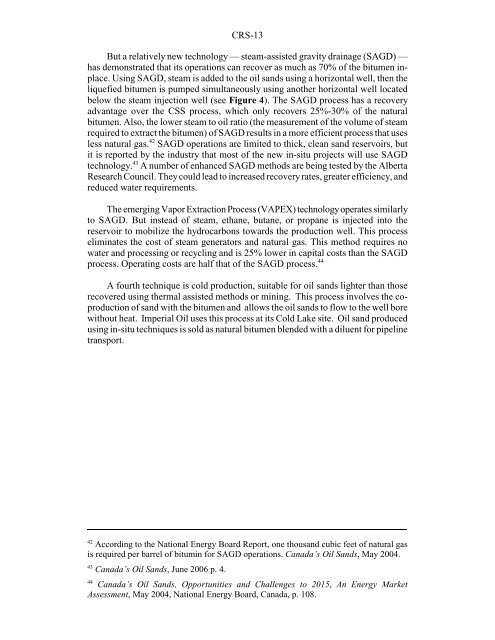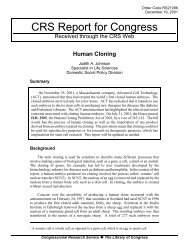North American Oil Sands: History of ... - The Air University
North American Oil Sands: History of ... - The Air University
North American Oil Sands: History of ... - The Air University
You also want an ePaper? Increase the reach of your titles
YUMPU automatically turns print PDFs into web optimized ePapers that Google loves.
CRS-13<br />
But a relatively new technology — steam-assisted gravity drainage (SAGD) —<br />
has demonstrated that its operations can recover as much as 70% <strong>of</strong> the bitumen inplace.<br />
Using SAGD, steam is added to the oil sands using a horizontal well, then the<br />
liquefied bitumen is pumped simultaneously using another horizontal well located<br />
below the steam injection well (see Figure 4). <strong>The</strong> SAGD process has a recovery<br />
advantage over the CSS process, which only recovers 25%-30% <strong>of</strong> the natural<br />
bitumen. Also, the lower steam to oil ratio (the measurement <strong>of</strong> the volume <strong>of</strong> steam<br />
required to extract the bitumen) <strong>of</strong> SAGD results in a more efficient process that uses<br />
less natural gas. 42 SAGD operations are limited to thick, clean sand reservoirs, but<br />
it is reported by the industry that most <strong>of</strong> the new in-situ projects will use SAGD<br />
technology. 43 A number <strong>of</strong> enhanced SAGD methods are being tested by the Alberta<br />
Research Council. <strong>The</strong>y could lead to increased recovery rates, greater efficiency, and<br />
reduced water requirements.<br />
<strong>The</strong> emerging Vapor Extraction Process (VAPEX) technology operates similarly<br />
to SAGD. But instead <strong>of</strong> steam, ethane, butane, or propane is injected into the<br />
reservoir to mobilize the hydrocarbons towards the production well. This process<br />
eliminates the cost <strong>of</strong> steam generators and natural gas. This method requires no<br />
water and processing or recycling and is 25% lower in capital costs than the SAGD<br />
process. Operating costs are half that <strong>of</strong> the SAGD process. 44<br />
A fourth technique is cold production, suitable for oil sands lighter than those<br />
recovered using thermal assisted methods or mining. This process involves the coproduction<br />
<strong>of</strong> sand with the bitumen and allows the oil sands to flow to the well bore<br />
without heat. Imperial <strong>Oil</strong> uses this process at its Cold Lake site. <strong>Oil</strong> sand produced<br />
using in-situ techniques is sold as natural bitumen blended with a diluent for pipeline<br />
transport.<br />
42 According to the National Energy Board Report, one thousand cubic feet <strong>of</strong> natural gas<br />
is required per barrel <strong>of</strong> bitumin for SAGD operations. Canada’s <strong>Oil</strong> <strong>Sands</strong>, May 2004.<br />
43 Canada’s <strong>Oil</strong> <strong>Sands</strong>, June 2006 p. 4.<br />
44 Canada’s <strong>Oil</strong> <strong>Sands</strong>, Opportunities and Challenges to 2015, An Energy Market<br />
Assessment, May 2004, National Energy Board, Canada, p. 108.











